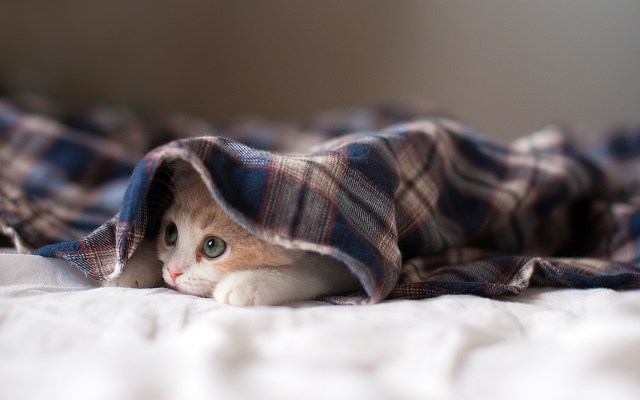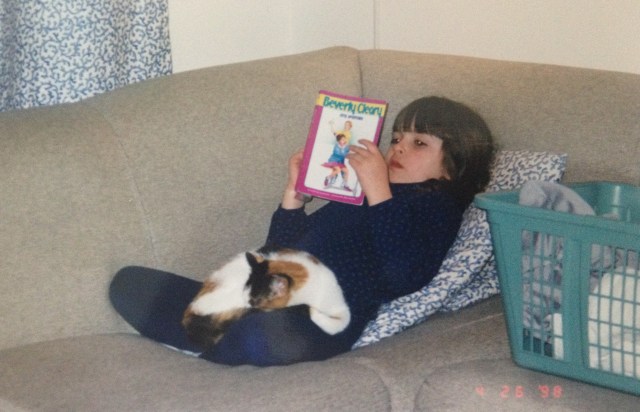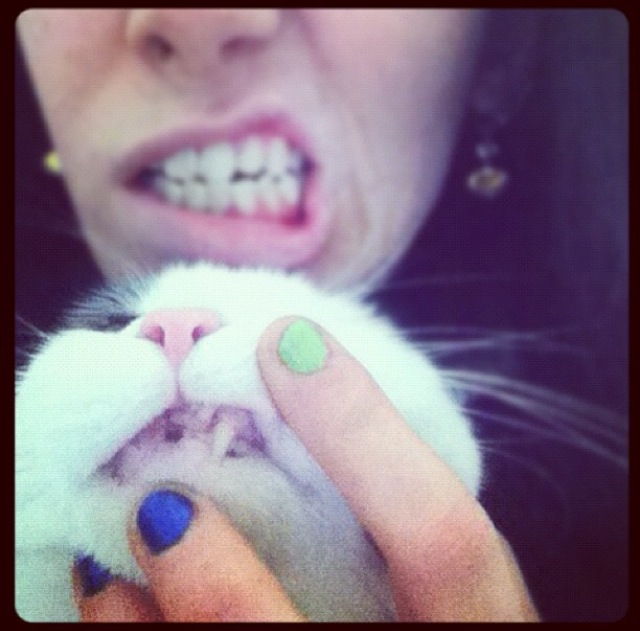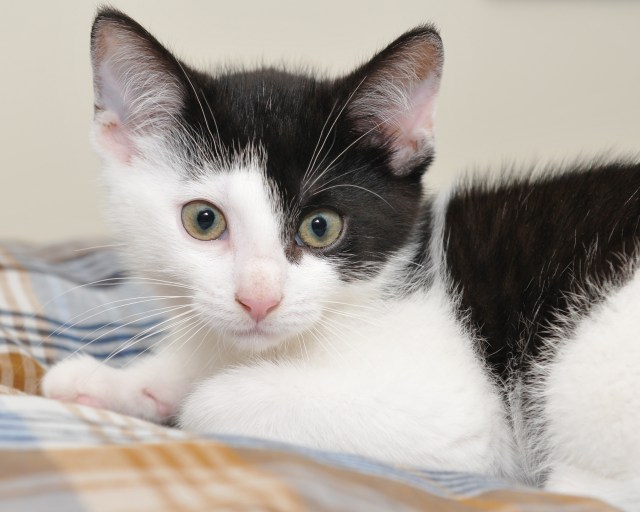Before we begin:

Okay, are we all properly misty-eyed now? No one can argue with animal adoption — offering a space in your home to a being who doesn’t have one, or even opposable thumbs, is a worthy cause. And we’re already on board with the Adopt Don’t Shop philosophy (adoption means saving a life!).
Let me tell you where I’m coming from: I’ve adopted three cats in my life. And not just cats, kittens. I never go in intending to adopt a kitten. I’m always like, I’ll adopt an older cat! They’ve already been socialized, they know manners, they’re not going to put everything in their mouths, it’s harder for them to find homes, etc. But the wand chooses the wizard, Harry, and the cat chooses the people. The first kitten I ever adopted jumped on my shoulder and then into my bag. The second kitten reached out through the bars of her cage and literally grabbed my fiancée by the arm and pulled her in close. The third started purring the instant I picked him up, he nuzzled into the crook of my elbow and the adoption specialist said, “Ugh. Please just take him. Just take him.”
We’ve covered adopting dogs. Now let’s talk about adopting kittens. Here are a few things you need to know and have when you’re taking home your very first feline fur-baby, speaking from the perspective of an adopter having done this three times now.

Are You Ready For a Kitten?
Kittens are far more than cute bundles of joy to hug and squeeze (lightly) and love. Remember that kittens grow into cats. My cat growing up lived to be 21. So you’re signing up to be a cat parent for a sizable chunk of time, if all goes well. And you’re signing up to deal with it if it doesn’t all go well (more on this later). Also remember that pets are part of the family — you’re going to need to care for this being through thick and thin, through cross country or even international moves. So here’s a small checklist.
- If you’re a renter, does your landlord allow cats? Are you aware of special circumstances surrounding pets in your building that you need to know about (like a deposit or pet rent)? If you’re already familiar, are those special circumstances something you can deal with? If you move, you intend to find housing that will allow your kitten, right?
- What about your lifestyle — does it fit a kitten right now? Having a kitten is kinda like having a sugar-high toddler. Kittens have a boatload of energy and none of the street smarts (or manners) that an older cat might have. You’re about to spend a ton of time pulling no-no items out of the kitten’s mouth, redirecting furniture scratching to appropriate scratching areas, and just generally staying up and worrying (kittens are babies, see if you don’t worry a little!). If you work non-stop or travel a lot, who’s gonna do that? Shelter animals often come from chaotic environments and they’re going to need their new forever home to be as stable as possible.
- Do you have the room? Sure, cats require less room than dogs. But lest ye have a 15 pound behemoth of a cat with weight-caused health issues, you need enough room for playtime, not to mention the litter box and the food dishes.
- Do you have the financial means to cover the adoption fees, food, supplies and medical care? If you can’t afford it, don’t do it! Volunteer at a shelter instead.
- Have you talked to everyone else you live with (partner, roommates, family, etc.) about adopting a kitten? Do they know what responsibilities they’ll have (litter box, making sure the house remains kitten proofed) when the new baby comes home? Also “talk” to any other pets that live in the house — are they good with cats? If you’ve got cat-aggressive dogs or a cat that would prefer to be an only furbaby, now may not be the time.
- Are you ready to take on the long-term responsibility that is kitten adoption?
- Are you ready to snuggle, love and possibly be groomed by your new bestie beastie?
If you answered yes to all these questions, or are willing and able to make adjustments to your “no” answers, sounds like you’re ready to start your kitten journey!

Okay, Now Are You Emotionally Ready for A Kitten?
I ask this completely sincerely. What are your motives here? And here’s why I ask it: have you recently lost a pet? I have. The first kitten I ever adopted, Puck (who y’all know from the Tampon Cat Toy photos), grew into a 3-year-old cat and got cancer. We did everything we could for him, but he lost his battle while I was away at A-Camp (luckily we are a two-person household, or I wouldn’t have been able to get to Camp at all). My fiancée and I decided to adopt another kitten for a multitude of reasons: our other cat (who y’all know from the Kitten-Approved Gin photos) needed a cat-friend to hang with (she was very sad), our family didn’t feel complete, and mostly? I wanted to honor Puck’s memory by offering the space in our home to another furbaby. That made emotional sense to me. But I’m still jumpy — I’m still looking for signs that the new kitten is going to die (probably he is not going to die and I’m just traumatized). So was I emotionally ready to adopt a kitten? I think probably as ready as I’ll be in a long while, but the jury is still out. Do I still think it was a good decision? Absolutely — I love our new little family member. But I still think it’s a good question to ask yourself. Did you just go through a break up? Did you just experience loss? Are you adopting a kitten because you think it will solve a problem? All things to think about before making a commitment that is definitely not as temporary as your emotional state. Bottom line: Do you have the emotional energy to devote to this right now? Do you have the capacity to be a good cat-parent despite your personal upheavals? If the answer is no, wait a while. Your kitten will find you when the time is right.
What to Expect From The Adoption Process
Finding Your Shelter
It is tempting to go about finding your kitten in the standard way, and there’s honestly probably nothing wrong with it. That way, in this day and age, is going on Petfinder and finding a kitten that you like the look of. That’s actually not how I recommend you do things. I recommend finding the shelter. You can’t tell anything about a kitten from the picture and the description anyway — rarely does one actually adopt the animal that piqued their interest, in my experience. Case in point: my brother and I recently looked at the same cat at St. Hubert’s Animal Shelter. With my brother, he was a lovely purring puddle. With my fiancée and I, he was a growling terrified demon. The best description and picture in the world isn’t going to tell you anything about your compatibility with the kitten. But Petfinder is a good way to see what shelters you’ve got in your area and what kind of animals they generally house.
Then go pay them a visit. With your actual body. Is the shelter clean and stable? Do you like the way they’re treating their animals? Do you like working with the people? When they speak to you, are they giving you good clear information? That’s how you know your kitten is coming to you from a loving home, a place with people who you will enjoy working with. If you have a regular pet store whose employees you like and trust, consider finding out if that pet store runs adoption days for local shelters. See who they work with and why. Find the shelter first, the kitten will come out of that experience. Who knows? Maybe your new kitten will reach out and grab you, too!

Some Common Adoption Practices: A Glossary
Not all shelters run the same way, so it’s hard to tell you exactly what you’ll be going through. But here are a few common terms and practices you’ll see around.
Home Visit. Some shelters will come visit your house before they’ll adopt a cat out to you. Pros: this shelter really cares about their kittens and about fit, and they will honestly tell you if they don’t think the kitten you’ve picked is the right little guy for you. If you’re new at kittens, you can glean a lot of information from these volunteers and professionals, so ask all the questions. They’re your encyclopedia for however long they’re in your living room. Cons: this process can take longer (but kittens are worth the wait!) and can leave you feeling like you’re inadequate, or like the shelter is trying to catch you out. They’re not. Keep in mind, the shelter really wants you to have this kitten. The home visits are there to make sure you know exactly what you’re doing, and that you don’t pick a nervous, only-pet kinda kitten when you’ve already got a feisty Pomeranian.
Adoption Fee. This varies depending on region, but most shelters charge an adoption fee anywhere from $50-$200 (adoption fees for dogs tend to be more than cats at any given shelter). My fees have always been in the $125 range. This kind of fee covers processing and paid help at a shelter, as well (sometimes) spaying/neutering and/or shots and vaccinations. Make sure you ask what’s included and what procedures have already been done (you’ll need this information when you have your first vet visit). Don’t ever believe the lie you tell yourself that you’ll remember what they tell you about their vet records, you won’t. So get it on paper or right it down as they say it. Sometime shelters will waive adoption fees for hard-to-place animals, but this rarely happens with kittens as kittens are generally easier to home.
Indoor-Only. I won’t get too much into my personal philosophy on this one (all of my cats forever have been indoor), but shelters will ask you your philosophy on this. And many shelters really prefer that you swear on the Kitten Holy that she will be indoor-only. Please do not lie to them if your philosophy is different than theirs. If they say indoor-only and you agree, indoor-only please. This is your local shelter, and they live the same place you do — they may be aware of risks in your area. If you have questions about the risks of the great outdoors or the benefits of indoor-only kittehs, ask your friendly shelter employees.
Regular Veterinarian. Many shelters will require you to have your vet’s information on hand before releasing the kitten to you. This is mostly to prove that you know what’s up and that you intend to take your pet to the vet (in fact, many shelters recommend a vet visit within ten days of adoption!). This can be difficult, though, if you’re adopting your very first furry friend. Again, know that the shelter really wants you to have this cat. So if you don’t go in with a vet already picked out, ask them who they’re using. Make your decision based on their information (and since you already picked a shelter full of people you like and trust, you can be confident that you’re gonna like their recommendation). Keep in mind that putting down that vet isn’t a contract that you sign in stone — feel free to try out different vets in your area until you’re totally happy. Hell, sometimes traveling a little bit is worth it (for instance: I live in New Jersey, but I use a vet in Pennsylvania because I like them so much).
References. Some shelters ask for references, so go in with the contact information of two people who have lived with you and know how you treat animals (yours and everyone else’s). If you don’t need them, awesome! You’ve at least shared the good news that you’re adopting a kitten! Probably they have squealed with you and asked to come visit when the baby comes home. If you do need them, it saves you from making a few hasty shotgun phone calls.
Landlord’s Contact Information. Again, the shelter probably isn’t calling your landlord. They just really want to know that you’ve cleared this with your landlord, and that there are no unknown pet policies. It’s devastating to an animal to get sent back because the landlord said no. Go in with this information (and having cleared the pet with your building). And know that some shelters may actually contact your landlord (though it’s never happened to me).
What You Need To Physically Possess or Do Before She Comes Home
Kitten Proofing
Loose cords, string/floss/tinsel on the floor, lilies or anti-freeze? None of that! All of these things can cause severe damage to a kitten (and there is no recovering from anti-freeze poisoning). Make sure you know what’s poison to cats and keep that out of reach (did you know onions and grapes can both cause damage?). Here is one list of food and plants that pose risks. Here’s another that includes a few things other than food and plants. Do a sweep — where can your kitten get to? Are there any holes in the back of cabinets that will let them into the walls (true story, I have one of those in the cabinet under my sink)? Can your cat get into your antique sewing machine (mine is currently stuffed with worn out exercise pants to prevent such an eventuality)? Get creative, because your kitten will get creative. Your kitten knows no limits. The limit does not exist.

Food
Unless you want the stinkiest cat butt in all of the world, go grain free. In my experience, my cats on grain free food are less smelly/farty than my cats not on grain free food, but there is as always some debate about that. And kittens don’t generally do terribly well on seafood flavors (again, stinky cat butt). But other than that, you’re good to go! You don’t even need to get special kitten formula food as long as you look for the AAFCO standard compliance on the label — that means it’s got nutrients for all life stages. Here are a few recommendations:

Fromm’s Grain Free Entrée. What I use. What I have used for a while. For wet food, Merrick‘s really gross looking but really good for babies and adult cats. Weruva People Grade Pet Food is exactly what it sounds like: people food for pets, and they also make BFF at a lower price point (fish-based, though, so for when your kitten grows up a bit). Blue Buffalo Freedom is actually a kitten formula for those who are a bit nervy with the “all stages” thing. Oh, and also Halo Grain Free is partially owned by Ellen. Why yes, I did manage to find you a pet food that’s partially owned by Ellen DeGeneres. You’re welcome.
You may also notice I’m recommending higher quality foods at a higher price point than, say, Iams or Meow Mix. That’s because making the choice to spend a little more on food will actually save you money and agony in the long run. Better food leads to fewer vet bills and a happier life for your kitteh.
Litter
One option is Fresh News, which I actually really hate. But if your cat has recently been spayed or had hernia surgery, you want a litter like this that won’t get into their wee little incision before it’s done healing. Dr. Elsey’s Precious Cat is what we currently use, great clumping and good for multiple cat households. The same company makes Dr. Elsey’s Cat Attract, which is great for new babies who need a little litter box encouragement. Blue Naturally Fresh — it is litter. Made out of walnuts. I want to try it so much, probably once I’m finished writing this I will ask my pet store to order it. Also don’t forget a litter box. Literally, any litter box. This is the one we use — the high sides and hood prevent tracking.
I also highly recommend a Litter Genie. It changed my litter life. It upped my litter game. And I no longer have to trudge all the way downstairs and outside every time I want to clean the litter box. I can just put it in the Litter Genie and my apartment doesn’t stink. It’s also cut down on my plastic consumption, because I can have several days worth of litter all in one plastic bag without the distinct cat odor.
Treats
There’s not a lot to say about treats except to try your best not to get the ones that are terrible for them — look for things that don’t have “byproduct” or nebulous meat things listed in the ingredients section, and again go for grain free (stinky cat butt, etc) and non-fishy ones for a little while. My kittehs have a clear favorite: Bravo Healthy Bites Chicken Breast. There is only one ingredient: chicken breast. There are no other ingredients to be concerned about. It is literally just freeze-dried chicken breast and that is all. Sometimes the chunks are a little big for tiny kitten mouths, but because it is only freeze dried chicken breast, you can just break the chunks up. They are soft.
I think the most important thing to know about treats is that if you start them off on the good stuff and never do the Friskies or Temptations, you won’t ever have to do the Friskies or Temptations. I wish I had known that with my first kitten. Perhaps then we could have gotten him to eat a Greenie Pill Pocket every now and again.
Toys
Cats will play with anything. Literally anything that kinda moves or looks like it will maybe move or squeaks or jingles or crinkles. And they will lose cat toys — under the stove, under the fridge, under the couch. So. Don’t spend a ton of money on cat toys that will disappear, savvy? And also — don’t get the ones whose strings could come off. String is extremely harmful when swallowed for cats of all ages. Instead, try jingle balls that come a million to a pack and a couple special soft toys. A dangler is always entertaining for all parties involved. Our household has had great success with tunnels and interactive cat toys (but ugh, they’re ugly and take up a lot of space, so we rotate them in — they live in the closet part time). When your kitten is under three months, don’t waste money upgrading to a catnip toy — though catnip is healthy and fine for felines of all ages, kittens under three months don’t react to it. Some don’t develop a reaction until six months. Some don’t ever react to catnip at all.
Also, if you have stuffed toys lying around that are wee enough, stuffed toys can make the perfect kitten friend. One of our kittens stole this stuffed donkey toy (named Earnest) off my fiancée’s childhood dresser when we were house sitting for her parents. They’ve been best friends ever since.
Other Special Needs
Nail trimmers are going to be essential — kittens have needle claws that will pull your sweaters and dig into your arms even during the most mild of play times. You’re gonna need to cut those nails. This will vary in difficulty depending on your kittens purrsonality. Also, believe it or not, poultry-flavored toothpaste (our vet gave us this one). Your cats are gonna need their teeth brushed (that’ll prevent vet visits for bad teeth, thus saving you money) and when they’re kittens is the very best time to get them acclimated (so you can do it without getting savaged). So put a little cat toothpaste on your finger tip and play with their gums a bit.

You’re also going to be doing a lot of redirecting from scratching furniture or rugs — make sure you have a scratching post to redirect to. There are small scratching posts, but the appeal of the furniture is that it’s a) tall enough that the kitten can stretch all the way out on it and b) heavy enough that it doesn’t move. So if you’ve gotten the wave and they don’t seem into it, try getting a big heavy one that mimics the favorite sofa. We have this exact scratching post and all parties are happy/all furniture is intact. Declawing cats is generally not recommended as it is the equivalent of amputating human fingers up to the second knuckle; it throws their balance off and can cause chronic pain.
Cat carriers are useful for getting your kitten to and from the vet/cat sitter/other places you’re likely to go with your cat. They are also useful to have in the event of an emergency where evacuation is required. I like the collapsible fabric kind so that it doesn’t take up so much room in the closet while not in use, but some people/kittens prefer the hard-sided carriers. If your kitten has just had surgery or has special needs that require her to be kept quiet-ish at present (no flying leaps onto the dining room table, for example), consider grabbing up a larger dog carrier with room for litter, water, food and general existence so your kitten can have a “play pen” while unsupervised. This may not be necessary for all surgeries, however, so talk with your friendly local shelter employees to find out about your individual kitten’s special needs.
And speaking of water and food, if you’re not intending to share your own dishes, grabbing up some stainless steel bowls for food and water is highly recommended. I say stainless because they last a long time, don’t retain odors, and many of them are dishwasher safe. Bowls on floors can be slide-y, so grab one with the rubber ring on the bottom or else a mat (and if your kitten likes to play with the water like mine does, grab the mat for sure).
The Naming of Cats
Alrighty, ready for the woo-ish portion of The Kitten Kit? Anyone who’s read T.S. Eliot knows that a cat’s name is very important. And I have always, in one way or another, gotten what I asked for when I picked a name. For example, our kitten called Jeeves is a compulsive groomer. He even grooms our eyebrows in the middle of the night. We picked the name before we knew about that gem of a behavior.

All I’m saying is, choose wisely. If you name your cat Houdini, microchip that sucker and fix those doors that don’t close quite right. And in the name of all your possessions, you might want to avoid “Mungojerrie” or “Rumpleteazer.”
The Vet, The Pet Store and Your Support Network
It’s almost time to set about enjoying the presence of your new best feline friend (or BFF). But do keep in mind, there are a few people and places you’ll now need in your life that you didn’t have before. You’ll need to find a regular vet if you didn’t already have one, plus the phone number for your local emergency vet (for off hours). Yelp is great for seeing who’s in the area, as is LocalVets.com, but keep in mind — people who have had negative outcomes (many of which could not have been prevented even by the best of vets) are more likely to leave a negative review, even if the vet was stellar. People who have had positive experiences may not think to leave a review at all. Seeing how the vet deals with you and your furbaby, personally, is always the best option. Asking pet owning friends and acquaintances for specific recommendations is also wonderful. Don’t hesitate to try a few vets and don’t hesitate to keep switching until you’re happy (not just with the way they treat your pet, but with the way they speak to you as well). Just make sure you have copies of all medical records to carry with you in the event of a switch. I like to keep mine all together in a folder. Post the phone number for the emergency vet on your fridge or in another central location — if you’re having an emergency, the last thing you want to be doing is Googling. Make sure all members of the household know where the emergency number is. Hopefully, you won’t need to use it. And hopefully you see your regular vet only for the standard stuff. Let’s all knock on wood, shall we?
You’ll be seeing your pet store, though, a lot more. So like choosing a shelter, it’s important to pick a place with a knowledgeable staff that answers questions confidently and clearly, and also knows where to find the answers when they don’t know. While some may not have options beyond Petsmart or even Walmart, I highly recommend choosing your local independent shop or even PetValu, a smaller chain, instead. It’s not always the case, but most often those employed at these kinds of stores have a lot more knowledge — and PetValu specifically has a program where they train their employees in training and nutrition through UC Davis. Smaller stores generally have a willingness to order foods or litters at your request, so talk to the employees if they don’t seem to carry what you’re looking for. And like your vet, try a bunch and keep trying until you find your favorite.
Lastly, it takes a village to raise a kitten (that’s totally how it goes). Mostly, your pet is your responsibility. But if you get snowed in over night somewhere, or you forget to turn on your air conditioning and it’s slated to be 90 degrees and you’re at work, it’s always nice if you’ve got a neighbor or friend you can call — someone with your house keys in case of emergency. These people in your life can sometimes function as pet sitters when duty (or vacation) calls. It’s always good to compensate them, but I’ve had great success in trading pet sitting duties.
So now it’s your turn — what did I miss? What tips and tricks for adopting kittens can you offer? DO YOU HAVE PICTURES OF YOUR KITTENS OH GOD PUT THEM IN THE COMMENTS PLEASE (and see this handy how-to for posting pictures in the comments section!).







